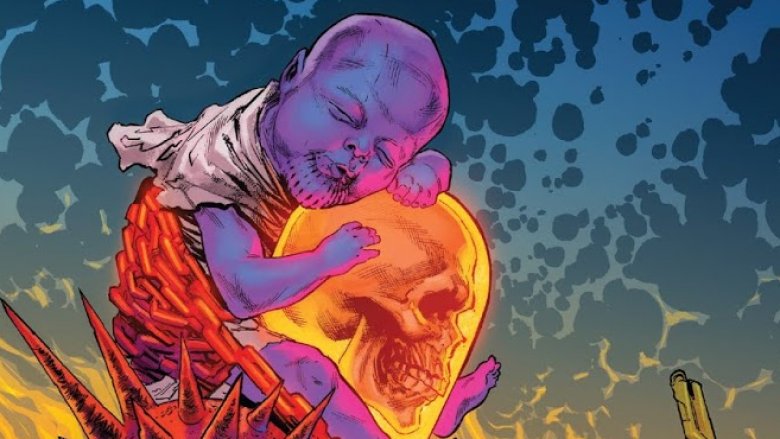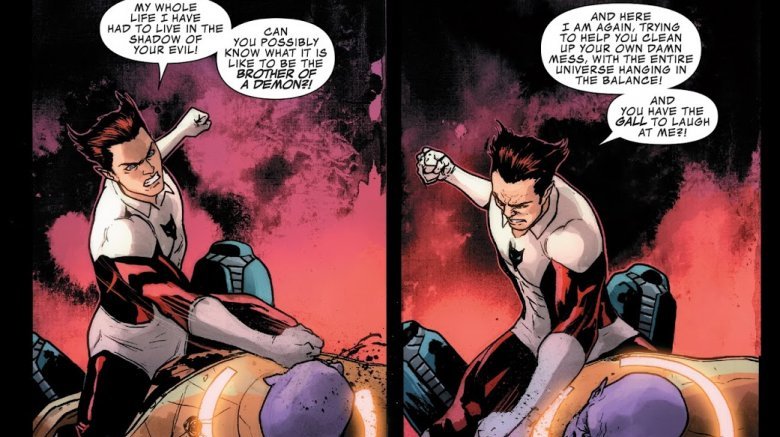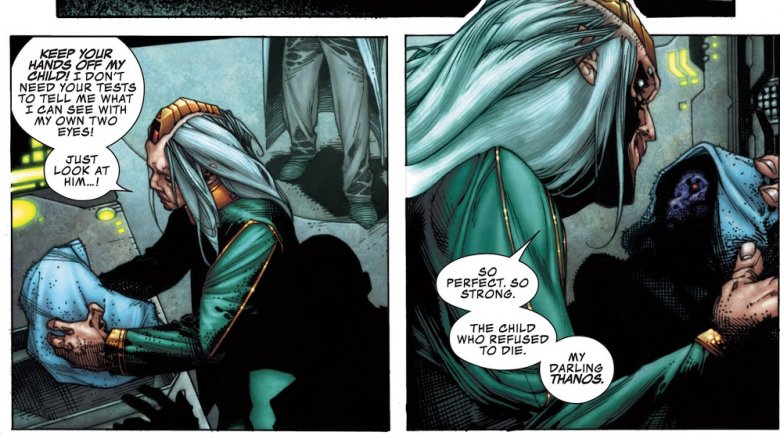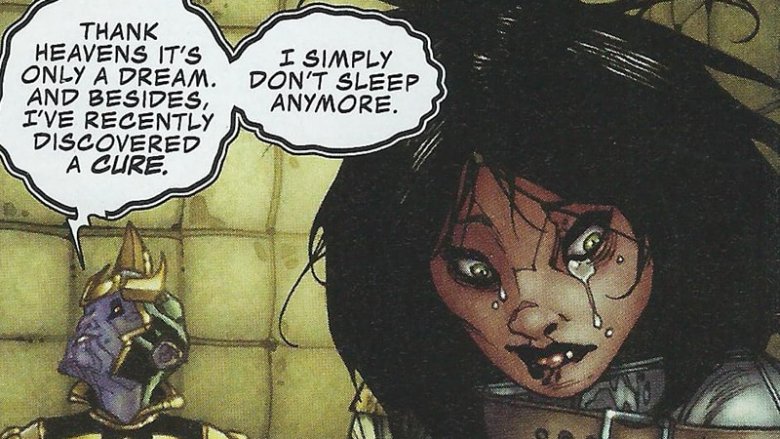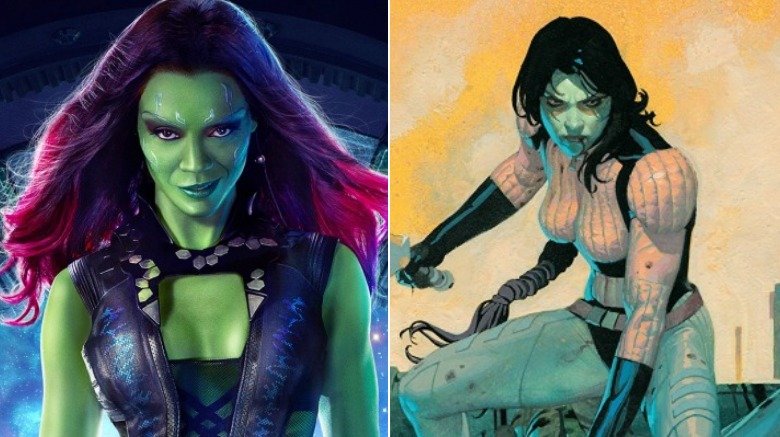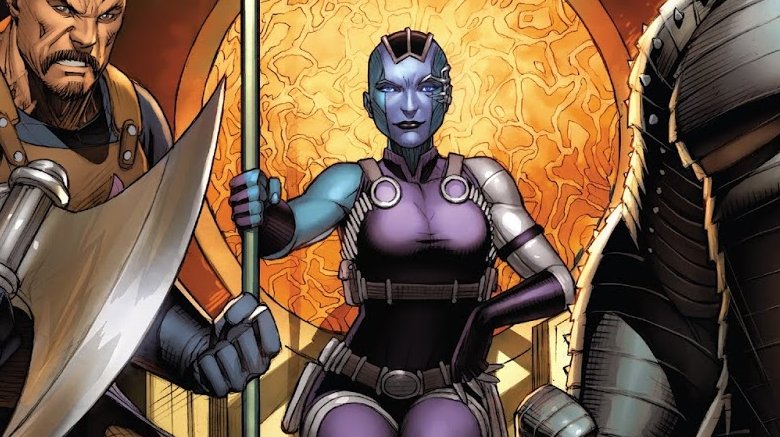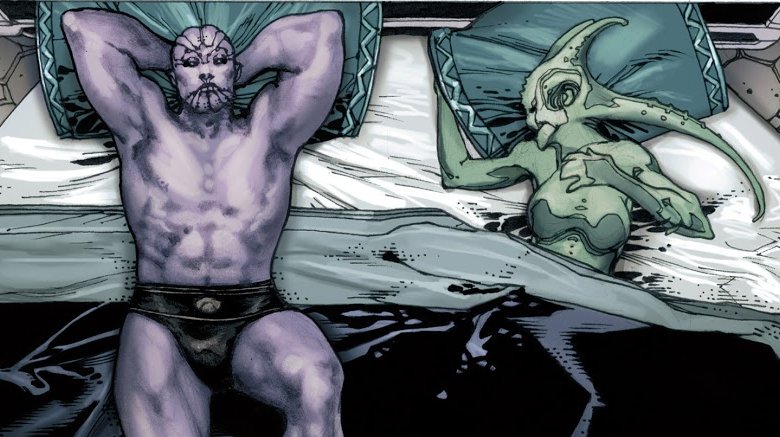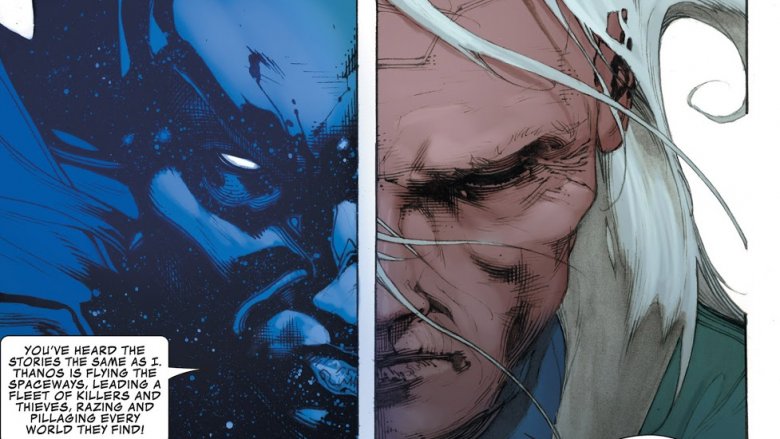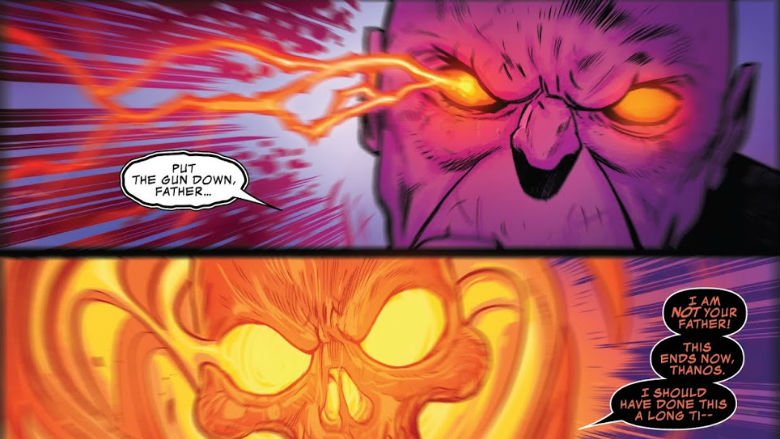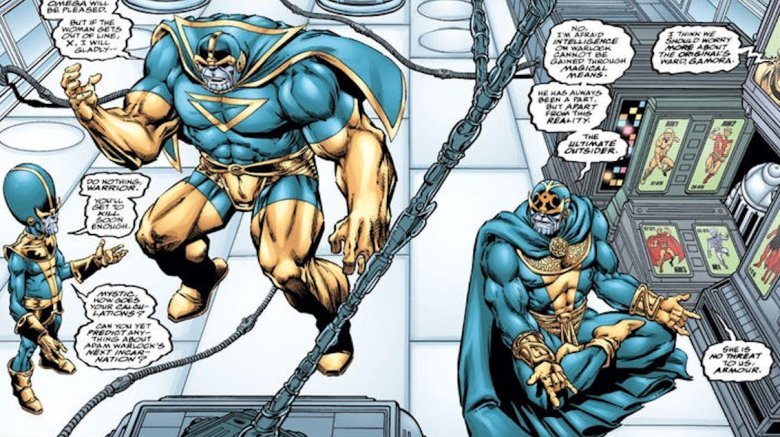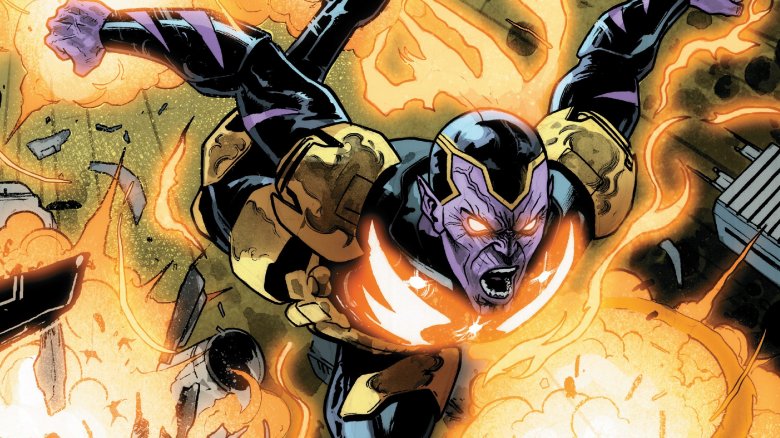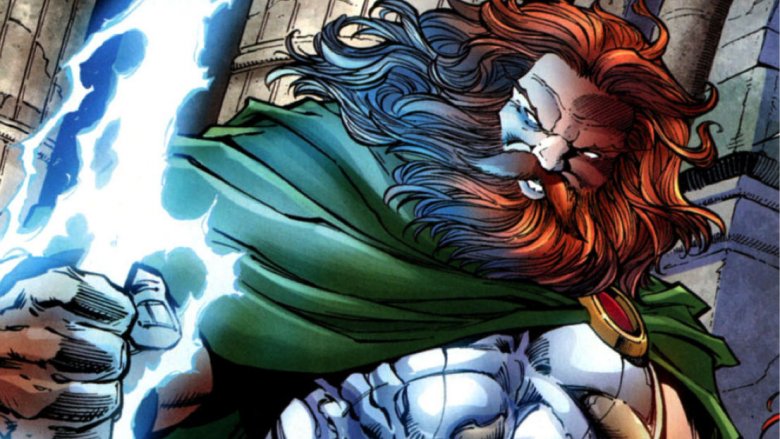What You Don't Know About Thanos' Family
When you think of Avengers: Infinity War's genocidal villain Thanos the Mad Titan, the phrase "family man" probably isn't the first to pop into your mind. As late as Infinity War we don't hear anything about Thanos' biological family — only his so-called "daughters," Gamora and Nebula, who he recruited from the worlds he's ravaged.
The truth is Thanos' family is an extensive one — in the biological sense as well as the broader sense of family Thanos chose, or those who chose him. Barry Lyga's prose novel Thanos: The Titan Consumed — which takes place within the MCU's timeline — sheds light on the villain's early upbringing as well as his relationships with Gamora and Nebula. Long before that, though, the comics introduced fans to Thanos' immediate family. There's his bookish father A'lars, his tormented mother Sui-San, and his brother, the alluring Eros, who served the Avengers as the hero Starfox. Thanos has gods and heroes in his family tree, and he fathered countless children who were murdered in their cribs. There are adoptive fathers, adoptive daughters, and even bizarre clones of Thanos' own twisted making. One claimed lineage she could never prove, and another became family when he jumped back in time to murder Thanos as a baby.
If any of that piques your interest, enjoy educating yourself on what you don't know about Thanos' family.
Oh, brother
If you saw Thanos standing side by side with Eros, you wouldn't recognize them as brothers. Eros, a.k.a. Starfox, is a handsome ladies' man who's just as likely to try and talk his way out of a fight as Thanos is to crush anyone who gets in his way.
While Eros has more luck with romance, in the comics that luck hasn't translated into good fortune when facing his more lethally minded brother. In his early appearances, Eros was little more than a prisoner of Thanos alongside his father A'lars, a.k.a. Mentor. Even in the 1991 miniseries Infinity Gauntlet – which revived Thanos' popularity and inspired Avengers: Infinity War – Starfox spent most of the time as a silent prisoner of his brother. Thanos used Infinity Stones to render Starfox helpless and literally mouthless. Starfox acts as narrator for Infinity Gauntlet #4 when Thanos murders (temporarily of course) Earth's surviving heroes, and Starfox can do nothing but watch.
While Thanos is the more murderous of the pair, Starfox's soul is not spotless. Eros has the ability to stimulate the pleasure centers of other people's brains, and in a 2006 She-Hulk story, the question arose of whether he had used his powers to convince women to sleep with him. In a later story in the same series, Thanos claimed that it was Eros whose powers created Thanos' obsession with death, thereby making Eros responsible for his brother's countless crimes. Unsurprisingly, Thanos' claim was eventually proven false.
Father of Mine
A'Lars, a.k.a. Mentor, leader of the Eternals on Titan and father to Thanos, is depicted differently in various media. In the 2013 origin miniseries Thanos Rising, Mentor was a loving but distant father who — when presented with the proof of his murderous son's crimes — refused to believe any of it even when the case was pressed by Kronos, Mentor's own father. In Thanos: The Mad Titan Consumed, A'Lars is cold to his deviant son and often seems disappointed in or even disgusted by him.
In all of his appearances, Mentor is shown to possess a genius-level intellect — and in the comics, he wields considerable physical might. In Thanos' earliest appearances, Mentor aids the Avengers and Captain Marvel against his wayward son who, among other things, uses his army of alien mercenaries to capture Titan and take his father and brother prisoner.
In both Barry Lyga's novel and in the comics, Mentor is no longer around. In The Mad Titan Consumed, A'Lars was a victim of the worldwide disaster Thanos had predicted years before. In the comics, however, Thanos took a much more active hand in his father's end. He sought out his father in 2017's Thanos #2, finding him among the ruins of Titan and asking for his help in diagnosing a mysterious illness. Mentor obliged, telling Thanos he was in the throes of a terminal illness — and for his trouble, Thanos punched his father through the chest, killing him.
A son only a mother could fear
In Thanos Rising #1 — because of either precognition, insanity, or a little bit of both — Thanos' mother Sui-San is the first in a long line of people who try and fail to kill Thanos. Shortly after her son is born, upon first resting eyes upon him, Sui-San is taken by a mad need to snuff out her newborn baby. She grabs a scalpel and as A'Lars holds her back she yells, "We have to kill it before it grows!" As Thanos becomes a young boy, we see that while she is no longer actively trying to murder her son, Sui-San is still considered dangerous. In her own home she is kept bound in straitjackets and she makes cryptic statements at dinner about her son's dark destiny. Thanos doesn't seem at all disturbed by his mother's strange behavior. He even tells her that he remembers her trying to kill him when he was a baby, though he says he believes it was only a dream.
Sui-San proved to be one of the darker steps on Thanos' path to villainy. As a child Thanos started trying to learn the secrets of existence — and by extension the secrets of himself — by secretly killing and experimenting on wildlife, and he eventually graduated to kidnapping local children and using them as lab rats. At the end of Thanos Rising #2, it is his own mother Thanos kills and dissects in his search for "self-discovery."
Same, but different
The Gamora played by Zoe Saldana in the MCU and her counterpart in the comics have a lot of differences, but they have a lot in common, too. Thanos in both narratives considers Gamora an adoptive daughter, though she has no biological connection to the Titan.
While in the movies it was the Chitauri who, under Thanos' direction, wiped out half of Gamora's people the Zen-Whoberis, in the comics Gamora is the last of her kind, who were exterminated by an interstellar religious people calling itself the Universal Church of the Truth. Just as in the films, Thanos found Gamora and raised her to be an assassin, but in the comics Thanos had a much more specific target in mind. He wanted Gamora to kill the Magus — the object of the Universal Church of Truth's worship as well as the evil version of Adam Warlock.
Gamora eventually turned on Thanos, though over the years they've occasionally worked together toward common goals, such as when they were both part of Adam Warlock's Infinity Watch or in the 2006 Marvel Comics event Annihilation. But their most recent interaction was not so friendly: The 2018 Marvel event Infinity Wars opened in Infinity Wars Prime #1 with Gamora assuming the identity of Requiem and beheading Thanos with a sword.
No granddaughter of mine
While Nebula claims no biological relation to Thanos in the movies, in the comics her connection to Thanos is much more nebulous (pun definitely intended).
Nebula first appeared in a 1985 Avengers storyline, having taken possession of Thanos' old ship Sanctuary and renamed it Sanctuary II. In Avengers #260 Nebula revealed her justification for claiming the ship — that she was Thanos' granddaughter. When Thanos was resurrected in the pages of Silver Surfer, his old ship was one of his first stops. Just before maiming Nebula, Thanos told her that of the crimes she'd committed, claiming kinship with him was the most unforgivable. He would later torture Nebula throughout Infinity Gauntlet, but he would pay for his cruelty: In Infinity Gauntlet #5 it was the nearly dead Nebula who took the Gauntlet from him.
Whether or not Nebula truly is Thanos' granddaughter remains a mystery. We know he has dropped "progeny" in spite of his objections in the pages of Silver Surfer, though he worked hard to kill them all. It's certainly possible one of them could have escaped. It's just as possible — and perhaps more likely — that Nebula constructed a story to earn a dark reputation among space pirates. It seems strange that among members of advanced alien societies, no one has thought of, you know, a DNA test. Or maybe Thanos just won't agree to a mouth swab.
Thanos got around
According to Thanos Rising, Thanos has many sons and daughters. But you'll never see them.
In Thanos Rising #3, we learn the young Titan is traveling the stars without any particular destination in mind. He travels from planet to planet, and on every world he eventually takes up with an alien woman and fathers a child. In every case, Thanos leaves without a word shortly after the child is born.
Later in the issue, Thanos runs into a woman who has dogged his steps since he was a child. We later learn this is Mistress Death, who will be so important in the villain's story. In the meantime, Thanos knows only that he desires her above all others. Mistress Death tells Thanos she knows of the many women he has been with over the years and their children. In order to prove his commitment to her, she demands that Thanos return to all of the planets where he had children with "alien harlots" and to murder both the women and the offspring. Proving how obsessed he is with Marvel's personification with death and the dark lengths to which he's willing to go, Thanos agrees.
Father of the gods
The grandfather of Thanos is Kronos, father to Mentor. A powerful being now composed completely of spirit, Kronos is one of the Eternals, an advanced offshoot of humanity created by the powerful Celestials.
If you're used to grandparents who are far more lenient with and doting towards their grandchildren, then you may have the wrong idea about Kronos. In Thanos Rising #5 — shortly before Thanos leads an armada to Titan and while Mentor still refuses to believe the truth about his son's true nature — it's Kronos who tries to force Mentor out of his denial. He tells Mentor that it was Thanos who murdered his own mother, Sui-San. In 1973's Iron Man #55, it's Kronos who resurrects Arthur Douglas and turns him into Drax the Destroyer specifically for the purpose of killing Thanos.
So he's pretty much just like any other grandparent. Except instead of trying to sneak the grandkids sweets and money when Mom and Dad aren't looking, he does everything he can to make sure his grandchild is utterly destroyed. And, apparently, doesn't do a very good job.
Cosmic Ghost Rider
In the most recent Thanos ongoing series, Marvel writer Donny Cates introduced a new anti-hero with one of the most confusing origin stories, so we'll skip it. We'll just tell you Cosmic Ghost Rider is an alternate reality version of Frank Castle (a.k.a The Punisher) with the combined powers of Ghost Rider and the Silver Surfer, as well as the sanity and often the dialogue stylings of Deadpool. Cosmic Ghost Rider didn't survive Thanos, but he impressed fans enough that Marvel greenlit a return in the 2018 Cosmic Ghost Rider miniseries. CGR was resurrected by Odin and used his second chance to try to rid the world of his old master: Thanos. He went back in time to kill Thanos in the crib but found he couldn't do it. Instead he kidnapped baby Thanos and tried to raise him in a way that would lead to less genocidal choices.
At the end of Cosmic Ghost Rider #3, while CGR is still protecting baby Thanos, a full-grown Thanos wearing a Punisher skull shirt appears and consistently calls CGR "father." At first, after seeing the idyllic planet Thanos governs, CGR believes he succeeded in raising a kinder, gentler Thanos. But soon he discovers that Thanos keeps the rest of the planet under a horrible tyranny. The two fight, and eventually the Punisher-Thanos is destroyed. CGR returns baby Thanos to his crib, unsure he'll ever find redemption.
The Thanosi
Marvel Comics published Infinity Gauntlet in 1991, Infinity War in 1992, and Infinity Crusade in 1993. Possibly they were worried if they kept going the next year would bring Infinity Redundant, so they took a break from Infinity stuff. But by 2002 fans would miss Thanos and his intergalactic apocalypse shenanigans enough to greenlight the miniseries Infinity Abyss by Thanos' creator, Jim Starlin.
Infinity Abyss introduced the bizarre Thanosi — clones of Thanos created by the Mad Titan himself and altered to reflect the abilities of some of Marvel's most formidable folk. Their purpose was as training for Thanos, to help him learn his greatest enemies' weaknesses. There was the bulbous-headed X, based on Professor X; Mystic, modeled after Doctor Strange; Armor, who was Thanos plus Iron Man; Warrior, designed to be like the powerful Gladiator of the Shi'ar Imperial Guard; and finally Omega, who was basically Galactus with a Thanos face. All five clones had Thanos' purple face with its ridged chin, and all five were less than appreciative when Thanos abandoned them. In Infinity Abyss the Thanosi attempted to kill their maker and then end the universe, but their plans were foiled by an unlikely alliance of Thanos, Warlock, Gamora, Captain Marvel, Spider-Man, and Doctor Strange.
The son that lived
The 2013 Marvel Comics event Infinity was a huge, star-spanning epic with lots of moving parts — and one of them revolved around Thanos' invasion of Earth. The event's title miniseries opened with the Black Order going from planet to planet, demanding the severed heads of all citizens of a certain age. Thanos had learned he had a child somewhere and that was a possibility he couldn't abide. We eventually learned that child was Thane, an Eternal/Inhuman hybrid. Thane was captured by Ebony Maw in Infinity #5, but Thanos never got to kill his son: In the following issue, Thane helped the Avengers defeat Thanos and the Black Order.
Thane returned in the ongoing series Thanos with a crushing inferiority complex and, eventually, a body count that climbed close to his dad's. At the behest of Mistress Death, Thane manipulated Nebula, Starfox, and Champion into helping him capture the destructive Phoenix Force. Boosted to beyond-godlike power levels, Thane nearly killed his father, who at the time was weakened by a debilitating illness. Beating up his dad wasn't good enough though, and Thane began exterminating life on a planetary scale. Once Thanos regained his power, he and his son had one final, huge dust-up with the Mad Titan as the victor.
Uncle Zeus?
Thanos' connection to Marvel's versions of the Greek gods is rarely mentioned, likely because that connection was retconned. We now know that Thanos is one of the Eternals, but this wasn't always the case. Thanos creator Jim Starlin wrote a different origin for the Mad Titan back in 1973's Captain Marvel #29.
While the cosmic entity Eon psychically communicates with Mar-Vell (Marvel's first hero to be called Captain Marvel), it unveils how Thanos came to be. Thanos' father A'lars lived on Olympus along with his brother Zeus and his father Chronos. A'lars was scholarly like his father, while Zeus preferred the ways of warriors and despised his father and brother for their bookishness. One day an accident in Chronos' lab destroyed the god's physical body but his spirit survived and roamed the cosmos. Zeus used Chronos' absence as an opportunity to seize control of Olympus and he immediately exiled A'lars. The wayward god settled on Titan, took Sui-San as his bride, renamed himself Mentor, and had two children: Thanos and Eros.
If the origin story had stuck, it would not only make Thanos nephew to the king of the Greek gods, but Starfox would no longer be his only relative with an Avengers membership card. He would count both Hercules and Ares as his cousins. It probably wouldn't get him a discount in the Avengers Mansion gift shop or anything, but it'd still be kind of cool.
